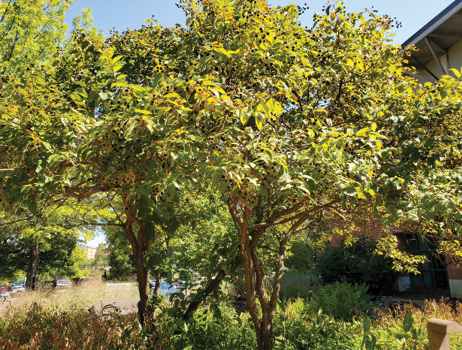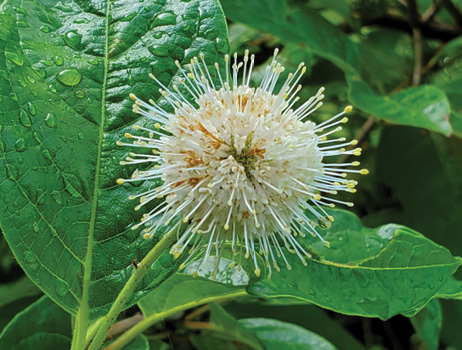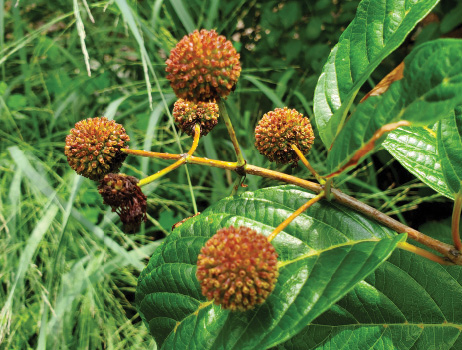Buttonbush | Cephalanthus occidentalis
Emergent | Native



Buttonbush is a marginal and shallow water woody bush common in wetlands, lakes, and ponds. Although normally relatively small, buttonbush can reach 45 feet in height with trunk diameters up to 1 foot.
Buttonbush leaves are shaped like wide swords and are up to 5 inches long and 2 inches wide. They are arranged oppositely on the stem. Healthy and growing leaves are usually bright green, while the leaf stalk may be pink to red.
Flowers are in globe-shaped clusters, with four to five small, white petals forming the sphere. Flowers turn brown after maturing.
Management Value
Buttonbush seeds may be eaten by ducks, and the flowers are popular with butterflies, bees, and other pollinators. Bird species frequently use this species for nesting. Buttonbush is usually in areas too shallow to provide fish habitat, but can be important during periods of high water.
Buttonbush is a good natural backdrop and mid-height plant that can be used to provide aesthetic benefits. However, it can interfere with pond access. Use with caution and be prepared to control unwanted expansion.
Recommended Controls
Option 1: Killing buttonbush is best achieved by felling with a chainsaw.
Option 2: Imazapyr (2-pound formulation). For small plants, mix 2.6 ounces imazapyr and 1.3 ounces non-ionic surfactant per gallon of water. Spray to wet all leaves.
Option 3: Glyphosate (5.4-pound formulation). For small plants, mix 2.0 ounces glyphosate and 1.3 ounces non-ionic surfactant per gallon of water. Spray to wet all leaves.
Treat with herbicides when plants are actively growing; tank mixing imazapyr and glyphosate may be more effective than using either option alone.
Read and follow all chemical label instructions, especially the section on the use of personal protection equipment.

The information given here is for educational purposes only. References to commercial products, trade names, or suppliers are made with the understanding that no endorsement is implied and that no discrimination against other products or suppliers is intended.
Publication 3735-20 (POD-11-23)
By Wes Neal, PhD, Extension/Research Professor, Wildlife, Fisheries, and Aquaculture; Dennis Riecke, Fisheries Coordinator, Mississippi Department of Wildlife, Fisheries, and Parks; and Gray Turnage, PhD, Assistant Research/Extension Professor, GeoSystems Research Institute.
The Mississippi State University Extension Service is working to ensure all web content is accessible to all users. If you need assistance accessing any of our content, please email the webteam or call 662-325-2262.



